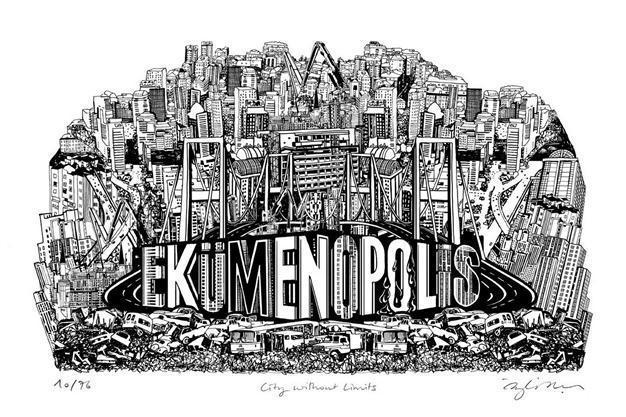Urbanization of Istanbul through the movies
EMRAH GÜLER ANKARA - Hürriyet Daily News

Perhaps, to understand urbanization, and later the uncontrolled urbanization, of Istanbul, one needs to take a look at Turkish cinema and to see how its love with Istanbul changed over the decades.
When the Gezi Park protests – albeit not so smoothly – transformed into speaking assemblies in some 50 parks in Istanbul, and nearly as many across Turkey, communication and solidarity were redefined within a matter of days. While citizens took the microphone to voice their concerns and opinions in these assemblies, called forums, one had fewer words and more silence 10 days ago.Istanbul’s Kartal forum screened a 2012 documentary on July 5 that resonated with the spirit of the last month and a half. In fact, it wasn’t the first time İmre Azem’s “Ecumenopolis: City Without Limits” was screened at a forum. The documentary was even screened in Gezi Park itself on June 13 when the park was a free zone before it was raided by the police two days later.
“Ecumenopolis: City Without Limits” takes a look at the effects of the neoliberal policies of the past, and more specifically in the last decade under the rule of the Justice and Development Party (AKP), to transform Istanbul from an industry-based city into a finance- and service-centered metropolis.
Interviews with academics, writers, contractors, city-dwellers, community leaders and activists show the harrowing impact of these policies over city-dwellers and shantytowns, as well as the environment. The documentary takes a look at the uncontrolled growth of skyscrapers, closed residential areas for the upper middle classes, and the so-called urban renewal projects for the poor, showing how they are widening the gap between the rich and the poor.
While the recent history elaborated in “Ecumenopolis: City Without Limits” might look like a prequel to the Gezi Park protests, it felt more like the news of an impending doom for Istanbul when it was released in 2011. Istanbul has been the epicenter of various battles for the last decade, with its nature and history having suffered a relentless massacre.
The third bridge over the Bosphorus that would destroy the remaining green area and the water supply in Istanbul, the giant mosque to be erected on the green Çamlıca Hill and redevelopment plans for Haydarpaşa Port, where the century-old Haydarpaşa Train Station greets people from land and the sea, have all been sources of major concern for Istanbul’s citizens in the past.
Perhaps, to understand urbanization, and later the uncontrolled urbanization, of Istanbul, one needs to take a look at Turkish cinema and to see how its love with Istanbul changed over the decades. Istanbul was a major player in almost all of the Yeşilçam melodramas of the 1960s and 1970s, serving as a promise for better lives futures.
Istanbul was the Turkish dream where rural Turkey watched in awe; the bourgeoisie depicted in these melodramas lived a Western life and looked like Europeans. The richer and the more urban the characters were, the blonder they got. It was also a period where Istanbul welcomed new citizens across rural Turkey, on and off screen. Haydarpaşa Train Station was the ultimate symbol of migration, always the final stop in a long train ride from stilted lives to brighter futures. Fish-out-of-tank stories always began with the character carrying her suitcase, looking scared and dumbstruck at Haydarpaşa.
Oh beautiful (and dark) Istanbul
The green hills of the Bosphorus served as the ideal backdrop to stories of love, heartbreak, hope and disappointment. As more people flocked to Istanbul, again both on and off screen, shantytowns began taking their places next to the dreamy mansions overlooking the Bosphorus. Academic Mehmet Öztürk cites late director Atıf Yılmaz’s “Suçlu” (Criminal) of 1959 as the first film to portray “the new urbanization of Istanbul,” to include scrappy shantytowns.
Until the 1980 coup, when Turkish cinema went into a stupor, Istanbul had been becoming a more diverse place where shantytowns and its characters began appropriating more screen time for themselves. Some of the films took place entirely in the slums of Istanbul like Yılmaz’s “Keşanlı Ali Destanı” (The Legend of Keşanlı Ali) of 1964 and Kartal Tibet’s “Sultan” of 1978. Others juxtaposed two faces of Istanbul, the affluent and the poor, more often the two in love stories, like 1966’s “Ah Güzel İstanbul” (Oh Beautiful Istanbul), directed by Yılmaz.
After the 1990s, Istanbul became a darker place, the hope of a better future felt in the movies of earlier decades leaving its place to utter alienation and a sense of nihilism. Director Zeki Demirkubuz’s classics of the late 1990s and early 2000s, like “Masumiyet” (Innocence), “Üçüncü Sayfa” (Third Page) or “İtiraf” (Confession), portrayed lost lives in a lost city to harrowing effects. Similarly, photographer-cum-director Nuri Bilge Ceylan’s Istanbul is a dreamy city that at once invites you to its beauties and leaves you in its bowels.Films in recent memory that take Istanbul as their setting are even darker, with characters’ hopes crushed to oblivion. This year’s “Zerre” (The Particle) by Erdem Tepegöz follows a single mother as she tries to make ends meet in the slums of Tarlabaşı, the epitome of urban renewal gone wrong. Reha Erdem’s “Hayat Var” (My Only Sunshine) of 2009 is yet another example where the 14-year-old character wanders aimlessly along the shores of Bosphorus, a decrepit shack serving as home to the lost lives of her family.
To portray a happier, uplifting, and a greener Istanbul, a little bit of hope should help. Maybe the spirit of the Gezi Park protests might just bring that.
















